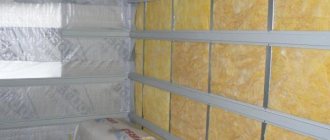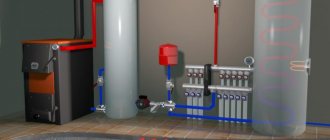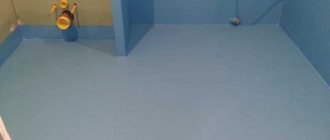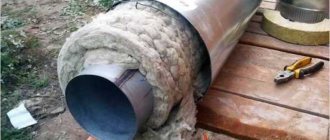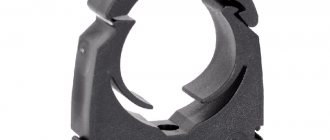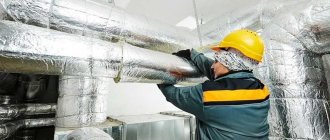Polyethylene is an unpretentious and inexpensive material, therefore it is actively used in everyday life and in some cases is irreplaceable. Sometimes situations arise in which it is necessary to glue the material, for example, when constructing a greenhouse. Not all compositions are effective in this case; you will need to use a special glue for polyethylene, which has excellent adhesive properties.
Technical characteristics of polyethylene
Polyethylene film is used as insulation, packaging material, and electrical insulator. It can reliably protect against moisture and absorbs neutrons, which are a type of radioactive radiation. Foamed polyethylene, otherwise called isolon or polyfol, is used to insulate a home - it is used to cover walls.
The question of how to glue polyethylene arises quite often. The usual composition is not suitable for these purposes, since the material is chemically inert. A special glue for polyethylene is required.
Polyethylene bonding is an electrical and chemical based process. The adhesive composition should adhere well to the surface of the film, and after hardening, reliably adhere the surfaces to each other.
There are two ways to firmly glue polyethylene:
- High temperature welding (iron).
- Use of adhesives.
Application area
Polystyrene foam is used in various spheres of life. A large number of materials and products are made from it. The material also retains heat well, so it is often used to insulate walls.
Areas of application of expanded polystyrene:
- Construction works. In construction, it is used for thermal insulation of structures, houses, buildings, garages, hangars. It is also used for external insulation.
- In shipbuilding. Lifebelts, lifeboats, and light boats are made from it. Also used to fill the compartments of small boats.
- In medicine. In this area, foam containers are used to transport organs and medicines.
- In furniture production. It is added to the composition of the material from which various pieces of furniture are then made.
- For the production of packaging materials. Added to various bags, packaging, wrappers, and so on.
- For the production of outdoor advertising. It is added to advertising structures - banners, signs.
- In clothing production. It is added to many fabrics. Clothes containing foam are very warm.
Types of glue and their manufacturers
The vast majority of adhesive compositions practically do not stick to polyethylene, simply being squeezed out from the area where the surfaces come into contact. But there are still materials that can cope with such a difficult task.
The most popular types of glue that can be used for polyethylene are:
- BF-2, BF-4;
- two-component acrylate;
- epoxy.
Butyraphenol glue (abbreviated as BF) is produced in Russia, manufactured by Petrokhim CJSC in St. Petersburg. The glue is a viscous, thick liquid of brown or reddish-brown color and does not rot or corrode.
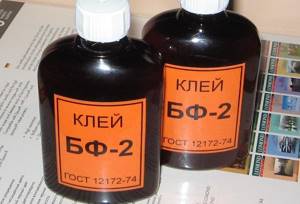
BF-2 is suitable for gluing metal, plastic, ceramics and wood, and is used for restoration work. Glue cannot be used for dishes, as it contains toxic aldehydes and phenol. BF-2 is universal, chemically inert and moisture resistant.
BF-4 is practically no different from BF-2 in terms of chemical resistance, but its scope of application is slightly different. BF-4 is usually used for gluing elastic materials that are subject to vibration and bending. For example, leather, wood, plexiglass, textolite, metals and alloys.
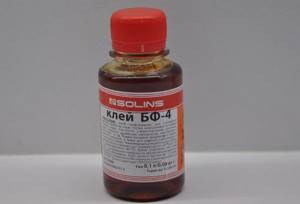
Two-component acrylate adhesive V-Strong GELIAHAO 302 is characterized by increased strength, it is transparent and does not harden very quickly (in 4 minutes), which allows you not to rush too much when working. Excellent bonding of metal and plexiglass.
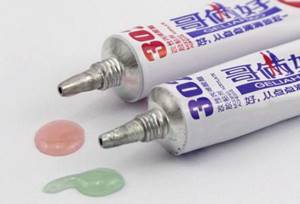
Transparent epoxy adhesive “Contact” ROSEL , St. Petersburg, based on polyepoxy resin and hardener. Used for repairing products made of fiberglass, porcelain, wood, earthenware, glass, metal and various alloys. The composition perfectly fills cracks, voids and gaps, restores the shape and volume of objects. The seam is characterized by resistance to gasoline, oil, and water.
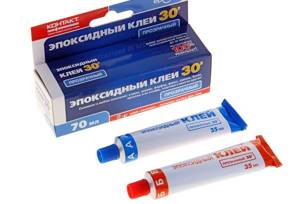
Device, circuit, principle of operation
An effective sewerage ventilation system in a private house consists of two key blocks:
- A ventilation duct from a cesspool or septic tank.
- Fan pipe in the house.
The principle of operation of ventilation with a cesspool:
- the pipe above the cesspool works as a supply system, air is drawn through it into the sewer system;
- through the drain pipe of the house, the unpleasant odor is released into the air space above the roof;
- when draining waste, excess air masses with an unpleasant odor are discharged through a pipe above the pit;
- the vacuum is filled by the exhaust pipe.
For such an autonomous system to work, it is important that the cesspool does not overflow and the ventilation pipe does not block the drains. The channel above the septic tank and the drain pipe must not be allowed to become clogged. For preventive purposes, the system should be equipped with inspection compartments and inspection pits.
They will help remove blockages, carry out repairs and restore ventilation if necessary.
For preventive purposes, the system should be equipped with inspection compartments and inspection pits. They will help remove blockages, carry out repairs and restore ventilation if necessary.
Many people associate an outdoor toilet in a country house with an unpleasant odor, dirt and danger. But modern summer residents strive to make such a toilet the most comfortable and safe place possible.
The design is a small cubicle, wooden or brick, with a toilet or seat located inside. There is a cesspool under the cabin, and it is this, or rather the accumulation of waste in it, that causes the unpleasant odor. During the process of decomposition, human waste releases a foul-smelling gas - methane, which, moreover, is also dangerous to health - a person can lose consciousness when visiting the toilet.
Methane vapor penetrates the wood and destroys it, as a result the wooden floors deteriorate and there is a risk of the structure collapsing. Hence the conclusion: it is necessary to prevent the accumulation of gases and ensure their free release. This is why ventilation is needed in an outdoor toilet.
Which is better
Among all the compounds that can glue polyethylene film, the leading position is occupied by Weicon Easy-Mix PE-PP , designed specifically for materials with weak adhesion. This is an acrylate glue with filler. It contains very small glass beads that do not allow the composition to slip out of the gluing area; they form a gap of optimal thickness.
the KLEYBERG 152-1 line is perfect for foamed polyethylene due to its unique composition and wide range of uses.
Which method is better?
Polyethylene molecules do not have a high electrical potential, so finding a substance that will stick well to the polymer is very difficult. Not only chemical compounds are used for joining; depending on the type and purpose of the structures, other methods can be used.
Craftsmen have found several ways to create a strong connection.
- Welding is used when gluing 2 polymer structures, especially for foamed polyethylene.
- Double-sided tape will help to fasten the plastic film together or attach it to structures made of some other materials, but such a connection cannot withstand heavy loads.
- Special glue.
In stores you can see a lot of ready-made materials, the packaging of which says that they are suitable for gluing polyethylene
Please note that the composition must include methyl acrylate
This component softens the polymer, which is especially important when working with thick films. It may also contain xylene and chromic anhydride.
It is convenient to work with this glue, it is ready for use and does not require additional surface treatment. The only negative is that the vapors are very toxic; you need to work with good ventilation or a respirator.
The composition may also include xylene and chromic anhydride. It is convenient to work with this glue, it is ready for use and does not require additional surface treatment. The only negative is that the vapors are very toxic; you need to work with good ventilation or a respirator.
There are preparations in the form of a thick paste, which must first be mixed with the solvent included in the kit. It is more difficult to use such glue; the working solution dries very quickly. If you do not have experience, prepare the glue in small portions. Epoxy resin has similar qualities, which can be used for gluing foam and ordinary polyethylene.
Application
Before using Weicon Easy-Mix PE-PP, thoroughly degrease and dry the surfaces. You can apply glue only from the mixer that is included in the package. The maximum mechanical strength of a polyethylene seam occurs after 4 or 5 hours. The optimal air temperature for work is from +21 to +23˚ C.
Advice: In its liquid state, the adhesive's shelf life is no longer than three minutes, so join the surfaces immediately after applying the composition.
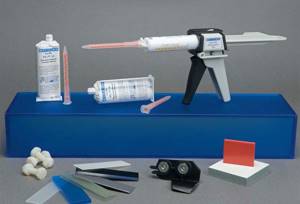
Epoxy adhesive is not intended for gluing polyethylene surfaces, but the phenol-formaldehyde resin included in its composition has excellent adhesion to such material.
Application of epoxy glue:
- Rub the areas to be glued with sandpaper, degrease and dry.
- Treat the surfaces with chromic anhydride (concentration solution 15-20%) or potassium dichromate (20-30%). You need to work with them with extreme caution, as these substances are very caustic and are dangerous carcinogens.
- After treatment, dry the surfaces.
- Prepare epoxy glue according to the instructions on the package.
- Apply a thin layer of adhesive to both surfaces and immediately join them.
- Leave for several hours, or better yet, a whole day at a temperature of +30 to +45˚ C, so that the seam completely hardens.
Tip Chromic anhydride and potassium bichromate can be replaced with a strong solution of potassium permanganate, which is also a strong oxidizing agent. It is no less effective, but at the same time safer, although it can also leave a chemical burn.
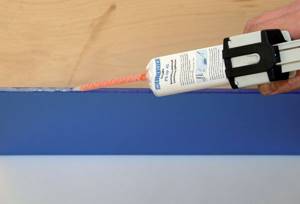
How can parts made from these materials be glued together?
There are two types of adhesive materials:
- single-component ones are sold ready-made (for example, “Moment” adhesive-sealant);
- two-component ones are a kit consisting of a base and a hardener, which must be mixed before work (for example, epoxy glue with a hardener or “Plasticfix”).
All adhesive compositions can be divided into three groups:
- cold cure (harden at room temperature);
- thermosetting (heating is required for their polymerization);
- mixed (polymerizes with and without heating).
Adhesive mixtures contain substances that dissolve the polymer and improve adhesion of the additive. The volatile solvent evaporates quickly, causing hardening at the joint. The parts form a single whole, which is why this process is often called cold welding.
Useful tips
Recommendations from specialists will help to glue polyethylene together efficiently, firmly and reliably, so that the products will serve for a long time:
- If very high demands are placed on the strength of the seam being formed, then the optimal method for gluing polyethylene is welding. The seam will be strong if it is not allowed to cool suddenly.
- Before using filled acrylate adhesive, no mechanical preparation of the surface is required. With the exception of degreasing and cleaning, which are carried out before gluing any surfaces.
- The seam formed after gluing the film with acrylate glue should be kept at a temperature from +15 to +70˚ C for 4-5 hours.
- Epoxy glue is difficult to work with, and the bond strength is not very good.
Tip You can create your own recipe for polyethylene glue by adding a little crushed chalk or cement to the acrylate glue. The composition can be of high quality and at the same time inexpensive.
The best option for gluing polyethylene is welding, since the result is a strong, reliable seam. It is not always advisable to use adhesive compositions, this is explained by the fact that polyethylene is a chemically inert material with weak adhesive properties.
Features of penofol fastening
Penofol (isolon) is produced by special foaming of polyethylene. The insulation is covered with aluminum foil, which maximizes heat retention. It is used for internal and external work, in finishing production mechanisms, preserving heat in pipelines or air conditioning systems. It comes in rolls and individual plates. It may have additional characteristics – thickness, color. The bonding of foil to the plane of foamed polyethylene can be chemical or physical (cross-linked).
Pros of penofol:
- small thickness;
- environmentally friendly;
- does not require additional skin and respiratory protection;
- there is no need for special tools;
- ease of fastening.
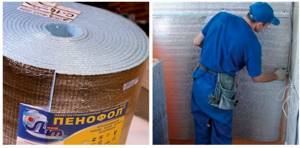
We attach penofol to glue (click to enlarge)
Double-sided insulation is used for thermal insulation of loggias, garages, and pipes. They are attached to the sheathing or purchased polyethylene foam with a self-adhesive surface.
Due to the lightness of the insulation material, the load-bearing capacity of the adhesive is not so important.
Polyethylene and its properties
Polyethylene is an organic compound. Thermoplastic ethylene polymer - many thin sheets needed in everyday life. The second name is cellophane.
Available in three density options: low, medium, high. Density affects the properties of the product. Low-density cellophane stretches and is elastic, while high-density cellophane is prone to cracking.
- The thicker the layer of material, the lower the transparency.
- At a temperature of -60 – -269 degrees, crystallization occurs, which will lead to cracking.
- Doesn't absorb water, doesn't even get wet by it.
- Without heating, it does not dissolve in organic solvents.
- If the temperature exceeds 80 degrees, then swelling occurs first, then dissolution in aromatic hydrocarbons.
- Shows resistance to many substances at normal temperatures.
- At temperatures above 60 degrees, it can be destroyed by sulfuric and nitric acid.
- The chrome mixture promotes oxidation of the polyethylene surface, resulting in wetting with water and the adhesive mass.
What glue to use for gluing polyethylene - composition
The easiest way is to purchase structural adhesive in the store, which contains methyl acrylate. Its properties ensure rapid softening of polyethylene and its further gluing. The glue also contains inorganic and organic acids and xylene, chromic anhydride and various additives.
The advantage of using the mixture is that no additional processing of the material is required. However, polyethylene glue is quite toxic, so it is recommended to carry out work outdoors. The glue acquires its best properties at a temperature of +35C; it is not afraid of moisture, but is flammable. It is better to buy it in specialized stores so as not to run into a fake.
If there is a need to combine polyethylene with polyethylene, it is more convenient and easier to resort to heat treatment.
This technique allows you to obtain a strong, unbreakable seam. Among the disadvantages of the method, it is worth noting the deformation of the edges of the product.
Mixtures for combining polymers are available for sale, with a consistency similar to a thick paste. An activator is included in the kit. After adding it to polyethylene glue, it acquires the necessary consistency and can be used for the near future.
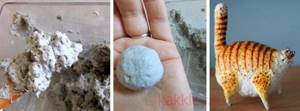
Gluing polyethylene - step-by-step instructions
To glue polyethylene, you do not need special knowledge and skills. Even beginners can cope with the task at home.
The operating procedure is as follows:
- Clean the surface and degrease it. Some manufacturers claim that this step is not mandatory, but experts still recommend spending a few minutes and under no circumstances skipping it.
- Apply glue to the treated material. It will only take a few minutes for it to harden, so the parts need to be attached to each other without delay.
- Leave the glued polyethylene elements for several hours until the glue completely sets.
In general, this algorithm is similar to working with any glue. However, you should take care to use protective gloves, since the glue can cause allergic reactions and is quite toxic.
It is more convenient to apply the adhesive using a glue gun, which can be loaded with ready-made cartridges. The mixture of them is distributed evenly, so it is easy to achieve the desired dosage. If you are planning a large amount of work, this device is worth investing in.
VIDEO ON THE TOPIC
How to glue foamed polyethylene
Foamed polyethylene has a porous structure, therefore it provides high-quality heat, steam and waterproofing.
Due to its low price, ease of operation and installation, it is actively used in construction. The most popular brands are Izolon, Vilaterm, Energoflex, Polyfom, Temaflex.
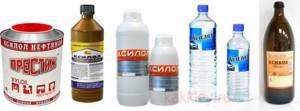
If there is a need to glue foam thermal insulation , experts recommend two-component adhesives based on methyl acrylate. Such compositions are characterized by high adhesion and are suitable for working with polyvinyl chloride, polyethylene, and polypropylene. An example is the well-known adhesive composition “Easy-Mix PE-PP” from WEICON.
Typically, in order to achieve high results in gluing polyethylene foam, the following procedures are additionally required:
- surface treatment by sandblasting or grinding,
- physical treatment, for example, thermal fire,
- chemical treatment (usually the fluoridation method is used).
Types of glue and their manufacturers
Initially, two-component compositions were invented. They came with a primer that was applied in a thin layer, providing a base before applying the adhesive (mostly a cyanoacrylate compound). That is, the primer serves as a kind of surface solvent to create a durable seam.
The negative side of using such adhesives is toxicity. When interacting with polymers, the primer releases substances that are hazardous to the body. It is not safe to use such connections at home.
The new type of glue is made from methacrylate. This is also a two-component mass, but without a harmful primer.
- Easy-Mix PE-PP from Weicon uses very small glass beads instead of a primer, which are distributed over the polyethylene, thereby increasing wettability and adhesion. There are no toxic compounds, so the product can be used at home. Before application, it is not necessary to clean the surface, only from heavy contamination. The paste-like product is ready for use, dosing and mixing occurs simultaneously, there will be no error in the ratio.
- BF-2 has a viscous, red-brown consistency. It has moisture-resistant, inert, universal properties. Contains toxic aldehydes and phenol.
- V-Strong GELIAHAO 302 is a two-component substance made from acrylate. Provides increased seam strength. The consistency is clear and hardens within 4 minutes, so there is plenty of time for adjustments.

Alternative bonding methods
As an alternative solution, you can offer products such as PVA, “liquid” nails and polyurethane foam. The first option may well replace specialized tools when it comes to gluing thin panels to a flat and adhesively favorable base in a room. Polyurethane foam will provide impeccable adhesion strength. If mechanical reliability is a top priority, then this option should be preferred. But you should also keep in mind that polyurethane foam will cause a lot of trouble if you need to dismantle the insulator. “Liquid” nails are also aimed at creating a strong bond, but this glue for gluing insulation can only be used outside residential premises. This is due precisely to the content of toxically harmful components.
How to glue foamed polyethylene
Foamed polymer is a type of polyethylene, which was obtained by introducing a gas hydrocarbon mixture into its structure. This produces a polymer with a porous structure, characterized by flexibility and practicality. Produced in the form of sheet, rope, roll.
To insulate the room, foam material with a foil layer is used.
Polymer foam adhesive:
- 88 Lux forms a durable, moisture- and frost-resistant seam. Ready for use, does not contain toxic compounds. It is permissible to treat large areas, as the stickiness remains for a long time. Complete hardening and formation of the seam occurs within a day.
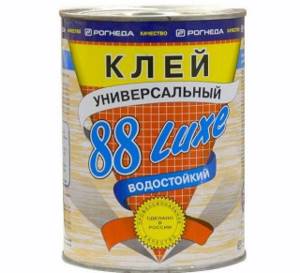
- Nairit 1 (88 P-1). Manufactured on the basis of chloroprene rubber. The seam is strong and elastic. Ready to use, easy to apply.

Also used for gluing: Foam rubber-2, 88-Metal. Since the choice of adhesives for polyethylene foam is high, you must adhere to the following criteria when purchasing:
- The operating temperature should be close to the insulation used.
- High adhesion must be ensured throughout the use of the material.
- For internal gluing, a compound without toxic compounds is used.
- For external gluing, an adhesive is used that can withstand changing weather conditions.
Features of gluing
Each surface has its own characteristics.
To concrete
Before applying glue, the surface must be cleaned, leveled, and treated with a primer. The composition is coated on the side of the insulating panel that is not covered with foil. After a minute, the plate is placed on the surface and pressed to glue it.
To metal
To bond polystyrene foam to aluminum or steel, builders advise buying liquid nails or products that can instantly glue the metal and the panel together. Polyurethane-based compounds provide a durable connection. For small volumes it is convenient to use double-sided tape.
How to glue at home
If there is a need to glue polyethylene at home, then you need to use IZ products. The gluing process depends on what base the film is attached to.
Interesting video on the topic:
Between themselves
The polyethylene film will stick to each other BF-2. But before work you need to prepare:
- The surface is thoroughly cleaned of dirt, dust deposits, and degreased.
- Apply a layer of adhesive, distribute evenly, connect the surfaces.
- Press for a couple of hours until the mass sets.
This preparation is suitable for all types of connecting compounds.
Glue - toxic compounds, work is performed with gloves.
In addition to glue, double-sided tape, soldering the ends between two metal plates, or molten plastic will help to glue the film.
To metal
In order for the polyethylene to tightly and reliably cover the metal surface, you need to do the following:
- the metal plane is cleaned and degreased;
- warms up to 120–150 degrees;
- the film is carefully stretched, gradually applied to a metal plane, and rolled.
To concrete
It is not difficult to stick insulation to concrete, the main thing is to follow the rules:
- the concrete surface is cleaned, leveled, primed;
- glue is applied to the side of the insulation where there is no foil;
- wait a minute for the glue to soak in;
- apply cloth, press;
- the edges are additionally coated and fixed;
- wait until it dries completely.
How to mount
Penofol is glued so that the foil side remains indoors. To enhance thermal insulation, an air layer 20 mm thick is created. To secure the panel:
- Glue is applied to the surface and the edges are coated.
- The slabs are connected joint to joint.
- Leave at least a quarter of a minute for the composition to set.
- Level the coating and smooth out wrinkles.
The insulation is finished with plasterboard and clapboard. Install decorative building material on the sheathing.
How to glue film (oilcloth)
How to glue polyethylene? There are a couple of possible answers:
- Iron welding. This is a fairly simple method, but it requires accuracy and subtlety of craftsmanship. To do this, the iron is heated to what temperature, it depends on the thickness of the material. The edges of the oilcloth are folded overlapping, then the edge or nose of the iron is drawn along the seam. Stay in place for no more than one second, as scorching will occur. Strength is checked by stretching two pieces of oilcloth.
- Open flame welding. For this method, you will need fire-resistant bars, between which the two edges of the film are fixed. An open flame from a match or gas burner melts the edges. This creates a dense bead that prevents the material from diverging.
We recommend videos on the topic:
Welding film with an open flame ↑
- one of the possible devices with an open fire: gas burner, alcohol lamp, blowtorch, match, torch;
- bars made of ceramic or metal.
First, the edges of the film are fixed with bars so that a narrow strip of polyethylene several millimeters thick is visible at the welding site. The bars should be made of metal or ceramics, but in no case from wood - after all, their function is not only to keep the polyethylene immobile, but also to remove some of the heat so that the parts being connected do not burn out.
After this, with the tool selected for welding, you need to draw a conditional line along the edge of the polyethylene parts. As a result, a dense connecting bead should form at the point where the films come into contact with the open fire. In order for the welding process to be successful, it is advisable to first, experimentally, select the optimal speed of the tool. It depends on the device used and on the brand of polyethylene.
Some tips for working with the material
When carrying out gluing work, you must follow the advice of the masters:
- If maximum joint strength is required, then only the welding method is used. In this case, the cooling of the weld should occur gradually.
- Cleaning and degreasing are carried out using any connection method.
- If acrylate glue was used, the connection should be kept at a temperature of 15–70 degrees for 5 hours.
- Epoxy glue does not provide the desired connection and is more difficult to work with.
- It's not difficult to make your own glue. To do this, crushed chalk or cement is added to acrylate glue.
Film gluing technologies and preparation for work ↑
Problems when gluing polyethylene are a fairly common situation. It's all about the characteristics of the material. Once you understand them, you can easily avoid difficulties.
What you need to remember from chemistry and physics ↑
Polyethylene is the most common polymer in the world. Its extraordinary popularity is explained by the excellent properties of the material - impact resistance, ductility, low gas and water permeability. Films reinforced with mesh or fabric are used for roofing, which increases the strength of the material.
Despite the advantages, polyethylene films are very rarely glued together in industry. To understand why connecting parts is problematic, just remember your school chemistry lessons. The molecule of this polymer is a long chain of similar -CH2- units. The charges inside such a molecule are distributed evenly, it is non-polar. And the higher the polarity, the more suitable the polymer is for gluing.
Connection methods without glue and solvent ↑
The method of gluing with its own solution, which is common for many polymers, is also not suitable - polyethylene is practically insoluble in organic solvents. The answer to the question: how to glue polyethylene film is actually very simple: it is best to use welding.
Of the many methods for welding polyethylene film, two are worth highlighting:
- Welding with a heated object.
- Open flame welding.
Both methods are equally effective, but in non-industrial conditions it is still easier and safer to use the first. However, everyone can choose the most suitable option for themselves, taking into account the availability of the necessary tools and their own skills. In any case, these methods make it possible to firmly connect parts together, creating reliable building elements, agricultural and protective structures.
Preparatory stages for work ↑
Popular wisdom says: “Measure seven times, cut once.” And before starting to work with polyethylene, you need to not only carefully take measurements, but also think through every detail. First of all, answer the questions:
- What loads will the finished structure be subject to?
- What is its expected lifespan?
- Do you need 100% hydro resistance?
Maybe after such questions the need to glue together many parts will disappear. For example, to insulate transported goods or preserve equipment, some parts of the plastic film can be secured with metal staples or twine. And to protect the building structure from moisture, it is recommended to overlap the polymer, covering individual parts.
But when the question arises about how to glue reinforced film for a greenhouse, you should not neglect reliability. After all, such a design, as a rule, should serve for a long time, perfectly protecting plants from all kinds of weather surprises. Connecting with staples and strong ropes will not work in this case, and welding (any of the proposed types) would be an ideal option.
Polyethylene and its properties
Polyethylene is a very common material with many excellent properties. It is used for insulation, for packaging, for protection from moisture, is an excellent electrical insulator, absorbs the most dangerous type of radiation - neutrons and is therefore used in protection against them, and is completely chemically resistant. This latter sometimes turns from an advantage into a disadvantage. How to glue polyethylene? Gluing is a chemical and a little electrical process, oddly enough. The molecules of the substances being glued are attracted to each other due to the difference in their electrical charges.
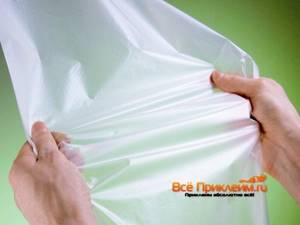
Polyethylene in hands
That is, there must be an adhesive in nature (and on the market) that adheres well to polyethylene, and when hardened, firmly holds the glued parts. So, the problem is that gluing polyethylene is very difficult. Its molecules are electrically very “balanced”, hence the extraordinary chemical resistance of the material. And a reluctance to stick to anything. However, the industry has found something to glue polyethylene with. True, not all of this is suitable for home, but some may come in handy. Here are the suitable methods, selected according to the resulting strength rating:
- Welding polyethylene
- Weicon Easy-Mix PE-PP Adhesive
- Epoxy glue plus oxidizing agent
We will consider these three methods further.
Glue selection
The range of adhesives for penofol on the modern market is quite wide
Therefore, it is important to take into account the different characteristics of materials
General rules
Penofol adhesive is selected based on the following:
- the product has durable adhesive properties;
- the thermal range coincides with the temperature characteristics of the insulation;
- a non-toxic certified product is used in the interior decoration of residential premises (apartment, office);
- for external finishing, you need glue that is resistant to temperature changes and weather conditions;
- saunas and baths require mixtures with water-repellent properties;
A water base will not create the required level of penetration into all the pores of foil polyethylene foam. The grip on the surface will be insufficient.
Choose what to glue with, also evaluating the surface:
- Weicon Easy-Mix PE-PP 45. Bonds polypropylene and polyethylene. It hardens for a long time;
- Titanium. Optimal for concrete base;
- Atlas Stopter K-20 glue. Adheres to mineral substrates;
- T-Avangard-K is used at high humidity;
- Contact Acrol or Neoprene-2136 spray is glued to penoplex;
- Ceresit and Olfix are universal - they are attached to any surface, including concrete;
The seams are treated with Tilite or special tape.
Welding polyethylene
The strongest seam is obtained when welding polyethylene. If done correctly. The fact is that polyethylene is hot molded, usually under very high pressure, which reaches hundreds of kilograms per square centimeter. And when it is reheated at atmospheric pressure until it melts, it tends to shrink, a little, but this is enough to make welding difficult. Two types of welding can be distinguished: film welding and thick polyethylene welding (canisters, pipes, etc.)
Application of polyethylene for greenhouses
PVC-based film is a very versatile material, which was originally invented as a packaging medium. However, the versatility of polyethylene has made it possible to use it much more widely, and today such modern oilcloth is used in many areas, including agriculture. PVC materials made it possible to replace heavy, fragile and expensive glass when covering a greenhouse in the summer.
- Conventional film based on polyethylene.
The most popular oilcloth among gardeners is for greenhouses. It is characterized by the lowest cost, and its sleeve-shaped design helps to double the covered area. Easy to install with your own hands. The standard service life is one year.
- Reinforced version of PVC materials.
It is represented by a plastic or fiberglass mesh welded to sheet material. The standard cell sizes of such polyethylene range from 0.8 x 0.8 to 1.2 x 1.2 centimeters. This PVC material is characterized by heterogeneity of structure and thickness, and when choosing, you should pay attention to the density parameters.
- PVC films.
They seriously compete with standard polyethylene film. PVC film has excellent physical and chemical properties, which allows the coating to transmit the light spectrum necessary for the growth and development of greenhouse crops. In addition, PVC materials are more resistant to low temperatures, and their service life is at least five years.
- Other types of films for greenhouses.
Copolymer, polyamide and air bubble films fall into this category. Manufacturers position such options as frost-resistant and do not require dismantling for the winter period. However, the high price makes it not very popular for covering greenhouses among Russian gardeners.
Gluing with acrylate glue with filler
The best glue is Weicon Easy-Mix PE-PP. It is specially designed for materials with weak adhesion. Most liquids “stick” to polyethylene very poorly and are simply squeezed out from the point of contact between the surfaces.
Appearance of Weicon Easy-Mix PE-PP glue
But this glue contains the addition of tiny glass beads, which prevents the glue from leaving the gluing area, forming a gap of the required thickness. Therefore, the gluing surface is sufficient and the glue, when hardened, holds the surfaces firmly together. It’s hard to find anything better than gluing polyethylene.
Surfaces must be thoroughly degreased and dried before gluing. Glue can only be supplied from a branded packaging mixer. The best temperature for doing work is +21. +23 °C. Liquid glue is good for no more than 2-3 minutes. After applying the layer, you must immediately join the surfaces. Full readiness of the seam (maximum mechanical strength) for polyethylene will be achieved in a few hours (4-5 according to the experience of those who worked with glue). The curing of the adhesive joint is carried out at a temperature from +15 to +70 degrees.
Use of Penofol
For such purposes, the material that is optimally suited is penofol, which has a layered structure and consists of aluminum foil supplemented with polyethylene foam. It is characterized by its low thickness and low weight, as well as ease of installation.

This material is used for finishing building structures, units of specialized machines and entire mechanisms, individual parts of technical equipment on a production scale, pipelines, air conditioning systems, drying cabinets, as well as inclined surfaces with a complex profile.
In order to ensure maximum steam, thermal, hydro and noise protection, Penofol must be glued to a previously prepared surface (cleaned and well-dried).
Before you begin gluing Penofol and the working surface, it is recommended that you read the instructions for the selected adhesive. However, there is one rule that applies to working with any adhesives, namely, all surfaces to be fastened must be clean and solid.
It is first necessary to eliminate existing chips and cracks, even the smallest irregularities, dirt, and blockages of various origins. If wooden, metal, or polymer surfaces require a primer, its chemical composition must be suitable for the selected type of adhesive. This is the only way to ensure maximum and strong adhesion of the fastening planes.
Selecting adhesive for Penofol
The modern construction market offers universal and special adhesives for Penofol, but all of them must correspond to the operating parameters of the material being described, namely:
- The temperature range of the glue must correspond to the performance characteristics of the insulation used.
- Persistent adhesive properties.
- Possibility of using a biologically non-toxic bonding composition when finishing indoor surfaces (residential, office).
Many conditions also depend on the target objectives. For example, when insulating external walls, the adhesive must be resistant to external factors - sudden temperature changes, snow and rain, direct sunlight, etc.
When working in baths or saunas, the adhesive must withstand sudden temperature changes and constant excess moisture.
If we are talking about insulating residential buildings and apartments, it is necessary to use polyurethane glue that is non-toxic and completely safe for the human body.
Types of glue
Since penofol is a fairly lightweight insulation material, the adhesive for attaching it does not pose great demands on strength.
- For exterior work, the range of operating temperatures is important, so it is best to choose mounting adhesive from the Moment Montazh Liquid Nails series. It is best to take “Super Strong Plus” glue, it is most resistant to temperature changes.
- For interior work, “Universal” or “Express” is suitable, as it dries quickly and can be used both outside and inside.
- Waterproof MV-40 is suitable for a bath or sauna.
- Weicon Easy-Mix PE-PP 45 adhesive is a specialized two-component adhesive based on methyl methacrylate, used for bonding PP polypropylene and PE polyethylene. The only drawback is the long hardening time (2-3 hours - preliminary, 1 day - full)
- For working with large quantities of penofol, PU-2 and PU-2A adhesives are suitable. They have good properties and are very durable, while being quite cheap. Unfortunately, these adhesives must be prepared on site: to do this, you need to mix polyester 24, technical acetone and polyisocyanate 102-T in equal parts. Portland cement is also added to PU-2 glue as a filler (0.25 parts).
- For small quantities, for example, when upholstering the inside of a car door or hood, it is better to use type C penofol with a self-adhesive layer. It is much more expensive, but it holds tightly and is absolutely harmless.
Bonding with epoxy glue
This is the most accessible method, if we talk specifically about gluing and not welding. Before gluing polyethylene, you need to prepare the surfaces.
Epoxy glue packaging
Epoxy glue is not a glue for gluing polyethylene, but, nevertheless, phenol-formaldehyde resin has very decent adhesion to the surface of polyethylene. In this case, you need to act like this:
- Roughen the surfaces with emery cloth, then degrease and dry.
- Treat both surfaces with a 15-25% solution of chromic anhydride or 20-30% potassium dichromate. (Caution, caustic substances and dangerous carcinogens!) You can take another strong oxidizing agent: a strong solution of potassium permanganate. It is not much less effective, but is much safer. After treatment, dry the surfaces again.
- Prepare epoxy glue according to instructions.
- Apply a thin layer of glue to both surfaces and join.
- Maintain at a temperature of +30. +45°C for several hours, but it’s better to leave it for a day until ready.
Other gluing methods
You can glue greenhouse polyethylene in other ways.
- The use of xylene and trichlorethylene heated to a temperature of seventy degrees, as well as through acetic acid heated to thirty degrees with a concentration of 80%.
- The use of certain types of glue. The best option is to use BF-two or BF-4 glue. The bonded surfaces must be pre-treated with a solution of chromic anhydride with a concentration of 25%.
- It is advisable to glue the polyamide film using PK-5 glue, and the resulting joint should be ironed with an iron heated to fifty degrees.
- Using a special super glue designed for gluing polyethylene materials. Such adhesives appeared on the Russian market relatively recently, but many gardeners and gardeners have already appreciated the ease of use. The glue is completely odorless, and the strength of the resulting connection is quite sufficient for using such material as a covering for greenhouse structures.
Of course, having a personal welding machine in the arsenal of any gardener with greenhouse or greenhouse structures is justified and can significantly save time and effort on gluing polyethylene-based films.
Russian manufacturers produce several special devices that allow you to weld polyethylene at home. The most inexpensive and high-quality device for such work is the PP-40 series device. In terms of external indicators, such equipment resembles a traditional soldering iron with a slightly modernized tip.
How to connect the joints of oilcloth for a greenhouse?
Cellophane bags are available. Quite durable. I want to make a greenhouse out of them. How correctly, and most importantly, with what, to connect the joints of pieces of oilcloth?
I would like to immediately note that in the picture in the explanation you showed bags made of plastic film. This is not cellophane (cellophane is a film material made from viscose)
Sometimes packaging products (bags, product packaging) made of polyethylene, polypropylene or polyesters are incorrectly called cellophane. These are different materials with completely different properties.
And polyethylene film is even more durable and quite thick, a very good material for a greenhouse. The main thing is that it is clean. Otherwise, it will have to be washed well, possibly using detergents. Next, the packages must be cut carefully and evenly; it is better to remove all irregularities in advance. In one of the questions, I already gave the answer to how to glue plastic bottles after cutting them to make a greenhouse. Here the gluing or joining procedure is much simpler, but the joint surface must not only be washed, but also degreased, then the joint will be more durable. We must immediately explain that this process of joining polyethylene film is not gluing, but welding. The industry produces special devices PP 25 and PP 40 directly for welding polyethylene at home. Here is one of such devices, although there are many brands and also imported devices.
But in everyday life, I used more inexpensive methods of welding polyethylene film. Sometimes I used a soldering iron, but more often I welded the polyethylene seam on an electric hotplate with a closed spiral. And finally, a video of how to weld plastic film.
Application of glue
Each brand of glue requires its own approach; all the intricacies of the work are described in the instructions for use. A good manufacturer will describe in detail how to prepare surfaces, apply the compound and make a good seam.
Before purchasing polyethylene adhesive, please read the manual carefully. There should be the following information:
- how to prepare the gluing area;
- do you need to wait some time after applying the composition;
- holding time - how long the seam should remain tightly pressed;
- drying time - after how many hours the product will acquire the required strength and be ready for use.
If the store does not have the required product, the builder is faced with the question: how to glue the polyethylene together? Masters have adapted to using other compositions. Sometimes surfaces need to be roughened or treated with chemicals. Crushed chalk or cement is added to acrylate glue, which increases the strength of the joint.
Manufacturer's recommendations vary. Sometimes surfaces need to be specially prepared. After application, some compositions need to be left for several minutes, then combined. When using other brands, the materials must be pressed firmly immediately after applying the composition. Read the instructions, everything is written there.
So, polymer film is an excellent material for the construction of greenhouses or insulation work. The polymer has one drawback: it is very difficult to choose a composition for gluing it. If you get to work, think: do you really need glue for polyethylene? Sometimes it is more convenient to use welding or double-sided tape. If you want to tackle such a difficult task as gluing polyethylene, first practice on small areas that do not require special strength and tightness. It’s impossible to learn how to do something solely from books and articles; get to work, don’t be afraid to experiment. Very little time will pass, you will get acquainted with the new material, learn its features, and very soon you will share with us your secrets of processing the capricious polymer.
Gluing polyethylene: instructions
As you can see, to glue polyethylene, you don’t need any special knowledge. The order of work here is familiar:
- clear out;
- degrease;
- dry;
- spread with adhesive;
- fasten the parts;
- press;
- leave until completely dry.
In this case, as when working with any other toxic substances, you should ensure that you have safety glasses, gloves and a respirator.
Good afternoon I had plastic films glued to the doors behind the door trims. They have become unusable (all torn). I ordered new ones. But what glue to use to stick them to the doors is a big mystery. I’ve already tried a lot of things, but so far only the Moment universal second gel really holds up. The trouble is that the second one sticks tightly and when you try to peel it off, the film breaks, but in the original it held up very well, but even when peeling it off, the film did not tear. The remains of the old one are relatively soft and will roll into coils with your fingernail. Can you tell me what kind of glue this could be? Moreover, it is necessary that the glue is not aerosol, but must be applied manually. I will list what has already been tested and what does not hold at all: - Moment extra strong 88 - Moment gel transparent - Moment Crystal - Moment classic 1 - Special rubber moment - Glue 66 metal - Moment plastic transparent glue
Properties of polyethylene
This wonderful material has many interesting properties. Polyethylene is used to protect against moisture, is an excellent electrical insulator and is capable of absorbing one of the most dangerous types of radiation. It is almost completely resistant to chemicals. It is this last quality that sometimes turns from an advantage into a disadvantage. How to fasten such material and how to choose glue for polyethylene?
Interestingly, gluing is not only a chemical, but to some extent an electrical process. The molecules of the substances being connected are attracted to each other due to the difference in their charges. Therefore, it is quite difficult to find a substance that adheres well to polyethylene, and after drying, firmly holds the fastened parts together. Since the molecules of this material are quite “balanced”, it can be very difficult to glue it with other elements. But still, the chemical industry has created an adhesive for gluing polyethylene. And not alone. Such an adhesive must have certain properties. Let's look at which ones exactly.
Reliable manufacturers and brands
To make the connection reliable and durable, you need to use a good adhesive. Companies that value their reputation do everything possible to make it convenient for the craftsman to work with their products.
If you don't know what to choose, pay attention to the appearance of the product. A self-respecting manufacturer will never pack the material in a box that tears at the first touch, or stick a nondescript, quickly fading label on the container with blurry text and an incomprehensible design.
Look at the instructions. It must be detailed and written in understandable language.
For gluing polyethylene there is a special adhesive Easy-Mix PE-PP from Weicon. It contains microscopic glass beads that give extra strength to the seam. The composition hardens very quickly, you should be able to do all the work in 3 minutes. If you can't find this brand, you can use standard plastic glue, but try it on a small area first. To ensure that the surface forms a strong bond with the glue, treat it with chromic anhydride. It is recommended to work at room temperature; the seam will gain full strength after 6 hours.
If you don’t find anything suitable in the store, you can glue the polyethylene with epoxy resin. With this option, surfaces require careful preparation. Rub the film with fine sandpaper until the surface loses its smoothness. Degrease, coat with an oxidizing agent and dry the gluing area. Spread on both surfaces, press them firmly together and leave to harden for a day.
Application for gluing plastics
Edible glue, intended for decorating pastries and pies, has a property that helps it be used for other than its intended purpose. Among kitchen utensils today, plastic utensils occupy a large place.
If your favorite plate, cup or food container gets cracked and breaks at the most inopportune moment, you can use food grade glue for a quick fix. To do this, it is necessary to dilute the SMS thickener (or carboxymethylcellulose) in water not in the usual ratio of 1 to 30, but in a more concentrated ratio of 1 to 45. The mixture is thoroughly mixed in a bottle with a lid. Its structure will gradually become homogeneous and suitable for use. If the consistency is too thick, you should add water to the composition.
After repair using edible glue, plastic utensils can last for a very long time without causing harm to those who use them.
Properties and applications
Since applying glue does not cause the product to lose its attractiveness, it can be used in a wide variety of cases. It is great for cardboard, paper, polymers, foil, textiles, foam rubber, as well as:
- sisal;
- polystyrene foam;
- beads;
- accessories;
- thread, yarn;
- wool;
- foamiran;
- ribbons, lace;
- floral decoration;
- polyethylene;
- photographs;
- napkins.
Most often, temporary glue is used on fabric for the purpose of creating patterns, securing patterns, sewing in zippers, and processing the crumbling edge of the fabric. The use of glue reduces time costs, reduces the number of defective products, while the result is beautiful and neat.
Needlewomen who work using the patchwork technique value temporary adhesives for the ability to attach yarn and threads to fabric with further stitching. Then the product is washed and the glue dissolves. It is very convenient to attach stencils to glue for a short period of time, and then easily remove them.
Other areas of application of the product:
- minor household repairs;
- design work, interior decoration;
- design of furniture, windows, curtains, curtains, doors;
- decorating rooms for the holiday;
- creating complex decor and appliqués on fabric;
- artistic activity;
- furniture production, assembly of individual components and fastening of small elements;
- some operations in electronics, mechanical engineering, light industry;
- production of advertising materials;
- creation of wall newspapers, posters, thematic stands and exhibitions.
Adhesives are most often sold in the form of sprays, although there are other types. The aerosol form is very convenient to use, because you just need to spray the adhesive onto the product. You can peel off the parts several times, which is very convenient when adjusting. Most temporary adhesives are freeze-resistant, waterproof, colorless, and odorless. Some compounds require subsequent mechanical removal or washing, others evaporate over time.
